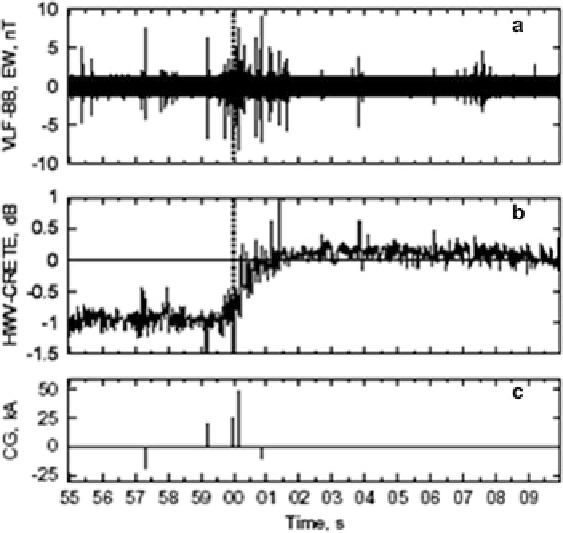Geoscience Reference
In-Depth Information
Fig. 3.25
An “early/slow” VLF event (
middle panel b
) which was observed in Crete at the distance
about 2,000 km from a convective storm in central France. The sprite appearance was detected at
the time marked by the
vertical dashed line
. A signature of the causative
CG discharge and other
CGs is displayed in the (
bottom panel c
). The sferics possibly associated with intracloud lightning
discharges were recorded by a broadband VLF receiver in Nançay, France, at about 200 km north-
east of the thunderstorm (
upper panel a
). Adapted from Neubert et al. (
2008
)
C
Hence the early VLF events can be associated with the lightning and sprite-
produced extra ionization in the D-region. In this picture the recovery time seems to
be controlled by the plasma relaxation time.
A new type of the so-called early/slow VLF perturbations associated with sprites
have been recently observed (Neubert et al.
2008
). An experimental evidence of
such events provided by the Crete receiver is shown in Fig.
3.25
(middle panel b).
The sprite was observed over a convective storm in central France at the distance
about 2,000 km from the receiver. This “early/slow” event is characterized by a
relatively long onset time of
2 s after the moment of sprite appearance. As is seen
from the bottom panel, this event can be associated with a few sequential CG light-
ning strokes. The broadband time series (upper panel a) provided by Nançay VLF
receiver exhibits a number of sferics possibly associated with bursts of IC lightning
discharges. Haldoupis et al. (
2006
) have assumed that the sequential electromagnetic
pulses radiated upwards from horizontal IC discharges accelerate sprite-produced
electrons which in turn can result in ionization of the lower ionosphere. One may
also speculate that the electron impact upon the ionosphere causes the generation

Search WWH ::

Custom Search